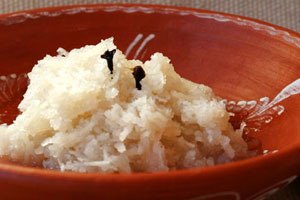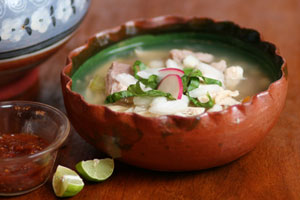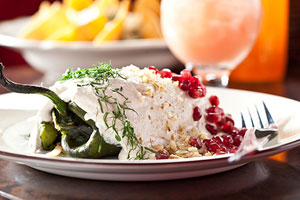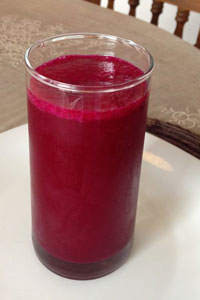In Mexico they don't just celebrate independence on one special day, but have an entire patriotic month, September, that arrives as a blur of red, white, and green. Flag sellers set up on street corners starting the end of August and excitement builds as residents young and old wait for the early morning hours of September 16th and the grito de independencia, when Miguel Hidalgo cried for freedom from the steps of his church back in 1810 and the War of Independence from Spain officially commenced. To help you celebrate this time of year with true patriotic grace, here are a few of the season's most typical foods, to be eaten as a meal or enjoyed throughout this mes de la patria.
The list starts with pozole, a Mexican favorite whose recipe dates all the way back to the Aztecs. Franciscan friar and ethnographer Bernardino de Sahagún talks about pozole in his Historia General de las Cosas de la Nueva España as a favorite of the corn-revering Aztecs.
In talking to a friend about the dish's enigmatic beginnings, he explained that “(The Aztecs) didn't make it as a 'dish.' They didn't have this modern concept of dish – a unique preparation made in a very special way, as we do.” They just threw in anything they had on hand, including, as the legend goes, human flesh, or tepezcuintle meat (a pork-like rodent).
These days the recipe is a little tamer, with lots of variations but generally including hominy, chiles, shredded meat (usually pork), tomatoes, garlic, and other spices. White and green pozole come from the state of Guerrero and red pozole is traditional of Jalisco (notice a color theme here?).
Next, chiles en nogada, cocadas, and more… [pagebreak]
The biggest culinary star of the independence season is Chiles en Nogada, a traditional dish from the state of Puebla. Its public debut was for the celebration of Agustin de Iturbide's upcoming signing of the Acta de Independencia in 1821, the document that would guarantee Mexico's freedom from the crown. This royalist turned freedom fighter was passing through Puebla on his way to Córdoba for the signing and was first served the dish as luxurious dessert (sans meat) by the Agustin nuns of the Santa Monica convent.
For this emblematic dish, roasted and egg-battered poblano peppers are stuffed with various fruit, nuts, and ground beef or pork. They are covered in a pale, creamy walnut sauce and garnished with parsley and pomegranate seeds – the sisters' tribute to the new flag of the independent Mexican state.
All of the dish's ingredients are grown in San Andrés Calpan, a town 30 miles from Puebla's capital. Beginning in mid-summer and into early fall, you will find this dish listed on menus across the country. There are also several chile en nogada festivals throughout Puebla in July and August, if you simply can't get enough of this dish.
Next, sweet bites to end your fiesta… [pagebreak]

No Mexican feast could be complete without a little something sugary at the end. There is no official Independence Day candy or dessert, but after all that heavy eating, I suggest something light and refreshing. Cocadas are a classic Mexican candy whose favorite variation of mine is edible lime peels filled with creamy, sweet coconut filling. If you don't want to hassle with hollowing out limes and soaking their peels for days at a time, you can just follow this recipe for the filling which can be rolled into balls or cut into squares.
Pulque
No party is complete without a little libation and although it's not typically tied to Independence Day, pulque is one of Mexico's oldest and most traditional alcoholic beverages. Pulque is made from agua- miel or agave cactus juice. Its makers scrape the inside of the agave cactus, separate out the pulp and leave the juice to sit and ferment in a cool place. The longer it's left to its own devices, the tangier and more fermented it gets, smelling yeastier as the hours go by. More aguamiel can be added to sweeten it for us wimpy pulque drinkers. For this particular season, my favorite flavored pulque is made with the florescent-colored prickly pear (called tunas in Spanish).
These magenta cactus fruits cover the central countryside in late summer, early fall. They are super sweet and stain everything they touch, but mix them with a little tangy pulque and it's like an effervescent berry pie in a glass. Tuna pulque can also be made with the green prickly pears whose flavor is often described as something between a pear and a melon. This drink will fill you up before it gets you drunk, but allegedly, aguamiel has curative qualities so bottoms up!

 Pozole
Pozole


![Making Mealtime Matter with La Familia: Easy Sofrito [Video]](https://thelatinkitchen.com/wp-content/uploads/2015/10/sofrito-shutterstock__0-500x383.jpg)
![Easy Latin Smoothies: Goji Berry Smoothie [Video]](https://thelatinkitchen.com/wp-content/uploads/2015/12/goji_berry-shutterstock_-500x383.jpg)
















![Fun and Fast Recipes: Fiesta Cabbage Salad [Video]](https://thelatinkitchen.com/wp-content/uploads/2015/11/fiesta_cabbage_slaw-shutterstock_-500x383.jpg)









